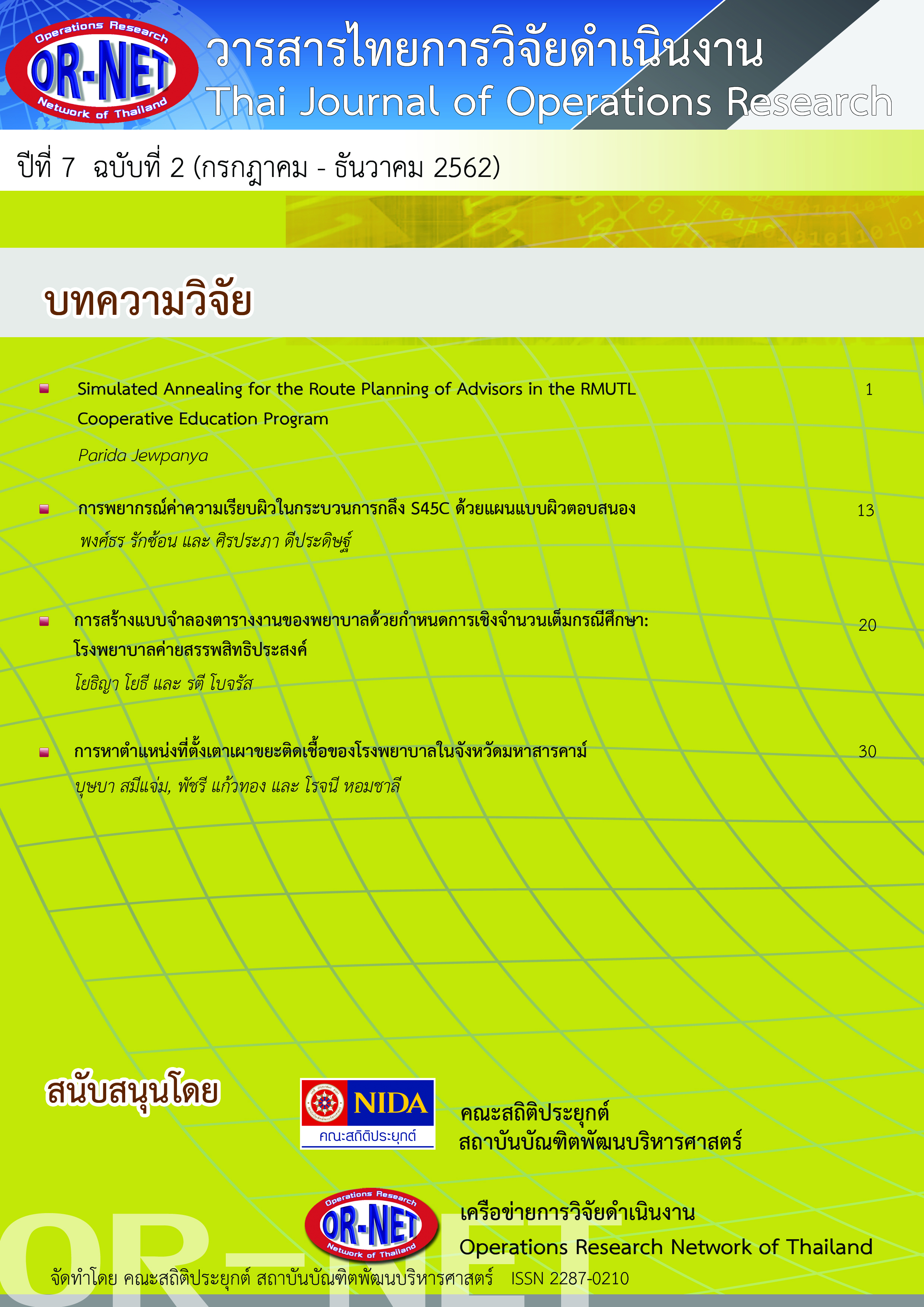The Prediction of Surface Roughness in the S45C Medium Carbon Steel Turning Process by Using Response Surface Methodology
Keywords:
Design of Experiment, Response Surface, Box-Behnken, Turning Process, S45C Medium Carbon SteelAbstract
S45C medium carbon steel is increasing on demand due to it has been applied in various fields. The objective of the research was to study appropriate setting of parameters and the regression model for surface roughness prediction in the S45C Medium Carbon Steel Turning Process by using Box-Behnken experimental design. Three control factors were investigated including cutting speed, feed rate and depth of cut. The results indicated that the appropriate setting to minimize the surface roughness were cutting speed at 300 meter per minute, feed rate at 0.20 millimeter per round, depth of cut at 0.10 millimeter. The appropriate setting produced the surface roughness of 0.5477 micrometer and the composite desirability equals 0.98911.
References
[2] กัมพล เพชรคง. ศึกษาปัจจัยที่ส่งผลต่อความเรียบผิวในการกลึงเหล็กกล้าไร้สนิม. ครุศาสตร์อุตสาหกรรมมหาบัณฑิต. ครุศาสตร์อุตสาหการ. มหาวิทยาลัยเทคโนโลยีพระจอมเกล้าธนบุรี, 2550.
[3] ธวัชชัย อาจปรุ. 2550. การศึกษาปัจจัยที่ส่งผลต่อความเรียบผิวในการกลึงเหล็กหล่อเหนียว FCD450. ครุศาสตร์อุตสาหกรรมมหาบัณฑิต. ครุศาสตร์อุตสาหการ. มหาวิทยาลัยเทคโนโลยีพระจอมเกล้าธนบุรี, 2550.
[4] มณเฑียร พลศรีลาภ. การศึกษาอิทธิพลที่ส่งผลต่อความเรียบผิวในการกลึงเหล็ก S50C. ครุศาสตร์อุตสาหกรรมมหาบัณฑิต. ครุศาสตร์อุตสาหการ. มหาวิทยาลัยเทคโนโลยีพระจอมเกล้าธนบุรี, 2554.
[5] I. Asilturk and H. Akkus, “Determining the effect of cutting parameters on surface roughness in hard turning using the Taguchi method,” Measurement,. Vol. 44, pp.1697-1704, 2011.
[6] B. Wua, J. Zhanga, L. Zhanga, Y. S. Pyoun and R. Murakamib, “Effect of ultrasonic nanocrystal surface modification on surface and fatigue properties of quenching and tempering S45C steel,” Applied Surface Science,. Vol. 321, pp.318–330, 2014.
[7] X. J. Cao, Y. S. Pyoun and R. Murakami, “Fatique properties of a S45C steel subjected to ultrasonic nanocrystal surface modification,” Applied Surface Science,. Vol. 256, pp.6297-6303, 2010.
[8] Y. F. Sun, Y. Konishi, M. Kamai and H. Fujii, “Microstructure and mechanical properties of S45C steel prepared by laser-assisted friction stir welding,” Materials and Design,. Vol. 47, pp.842-849, 2013.
[9] B. Wua, P. Wang, Y. S. Pyoun, J. Zhang and R. Murakamib, “Effect of ultrasonic nanocrystal surface modification on the fatigue behaviors of plasma-nitrided S45C steel,” Surface & Coating Technology,. Vol. 213, pp.271-277, 2012.
[10] K. Kida, E.C. Santos, M. Uryu, T. Handa, J.A. Rozwadowska and K. Saruwatari, “Changes in magenetic field intensities around fatigue crack tips of medium carbon low alloy steel (S45C, JIS),” International Journal of Fatigue,. Vol. 56, pp33-41, 2013.
[11] พงศ์ธร รักซ้อน. “การศึกษาปัจจัยที่ส่งผลกระทบต่อความหยาบผิวในกระบวนการกลึงเหล็กกล้าคาร์บอนปานกลาง S45C”. ประชุมวิชาการข่ายงานวิศวกรรมอุตสาหการ ประจำปี 2561, 23-26 กรกฎาคม. โรงแรมสุนีย์ แกรนด์ โฮเทล แอนด์ คอนเวนชั่น เซ็นเตอร์: 936-938, 2561.
[12] ประไพศรี สุทัศน์ ณ อยุธยา และ พงศ์ชนัน เหลืองไพบูลย์. การออกแบบและการวิเคราะห์การทดลอง. พิมพ์ครั้งที่ 1. กรุงเทพฯ: บริษัทสำนักพิมพ์ท้อป จำกัด, 2551.
[13] D.C. Montgomery, 7th ed., Design and Analysis of Experiment. New York: John Wiley & Sons, 2009.
[14] D.C. Montgomery, G.C. Runger and N.F. Hubele, 5th ed., Engineering Statistics. New York: John Wiley & Sons, 2012.




